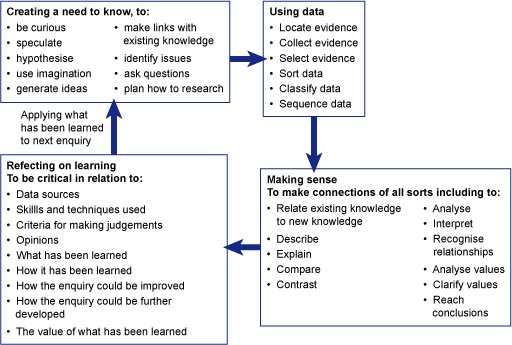2.1 Using an enquiry approach
In geography, there are a range of opinions about what an enquiry approach to learning means. Roberts (2003, p. 37) states that ‘an enquiry approach to learning recognises that knowledge is not something “out there” ready to be learnt; it is generated in the process of answering questions’.
Activity 4 allows you to look at geographical enquiry in more depth.
Activity 4 Geographical enquiry
Part 1
Listen to the teacher explaining his experience of enquiry-based learning.
Transcript
Enquiry-based learning
Part 2
Read through Geographical enquiry [Tip: hold Ctrl and click a link to open it in a new tab. (Hide tip)] (Roberts, 2010). On page 6 she says:
how people understand geographical enquiry is influenced by their own personal biographies, the ways they have encountered enquiry through their study of geography.
Reflect upon how your ‘biography’ has influenced your understanding of the objectives, operation and outcomes of enquiry-based learning.
Make three lists or a mindmap to identify the following:
- examples of how your own educational experience was similar to the approach advocated by Margaret Roberts
- examples from your own teaching or teaching you have observed
- the features of the enquiry approach to learning that will promote engagement.
If your own experiences do not seem to match up with an enquiry approach, consider ways in which the learning and teaching could be adapted to focus and build on students’ curiosity and questions. Provide some examples.
Part 3
Roberts (2010, p. 7) states:
I think of geographical enquiry as an approach to learning that accepts that knowledge has been constructed and prioritises the need for students to make sense of things for themselves – an approach which could include individual projects. I do not see it as an optional approach, to be used occasionally.
What challenges have you experienced, or do you foresee, in embedding the enquiry approach to learning rather than using it only occasionally?
How might you overcome these?
Part 4
There are many examples of resources made by teachers. Web-based enquiries can be seen at Staffordshire Learning Net (SLN). These aim to develop ‘critical literacy’ by encouraging students to question the validity of the information they retrieve. They are written to encourage students to ask the following:
- What is the source of information?
- What is the purpose of that information?
- What is the motivation?
- Who is represented? Who isn’t represented?
- How does the website persuade us?
- Are there alternative views?
Spend some time reviewing the SLN resources.
- How far and in what ways do they fit with your ideas and those of Roberts (2010) about an enquiry approach to learning?
- How could you use and adapt them?
- If you were to design a web-based enquiry, would you use the same questions? What topic would you choose?
An enquiry approach, as understood by Roberts, includes four important aspects:
- creating a need to know
- using data
- making sense
- reflecting on learning (Figure 2).
It fits with a constructivist understanding of learning. Learners build on ideas they already have in order to question, understand and internalise new information (Ferretti, 2013, p. 105), interrelating, reinterpreting and trying to understand new experiences and ideas.
Ferretti (2013, p. 102) observes that enquiry learning has long been advocated as an important approach but its use in secondary teaching and learning is limited. This may in part be due to the skills and confidence of both teachers and students. Other challenges include a drive in many schools to have a standard approach to lesson planning, often including narrowly defined, differentiated outcomes and three-part lessons. An assessment culture that focuses on ‘coverage of the subject’ and progress can also be seen to be at odds with an enquiry approach. These and other concerns are discussed by Ferretti (2013, pp. 109–112).

